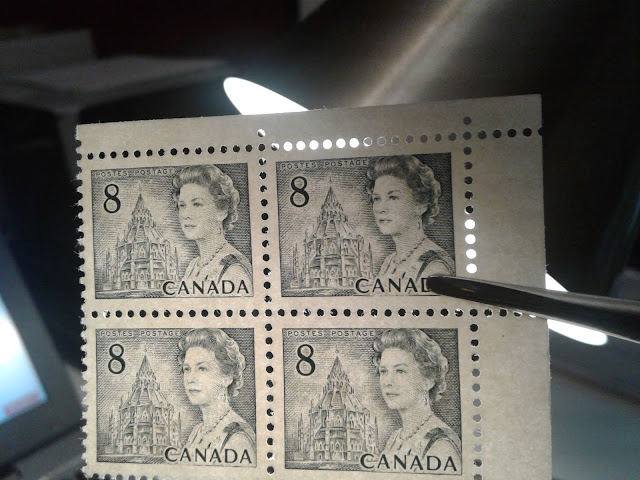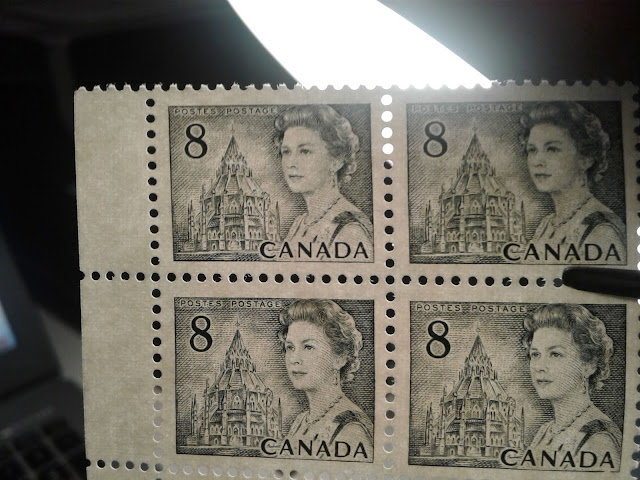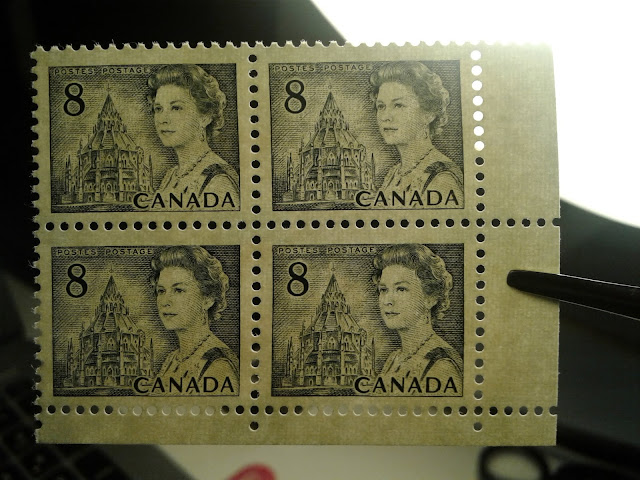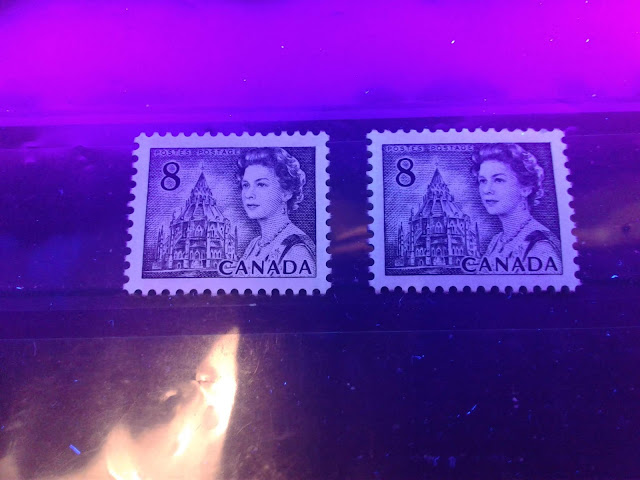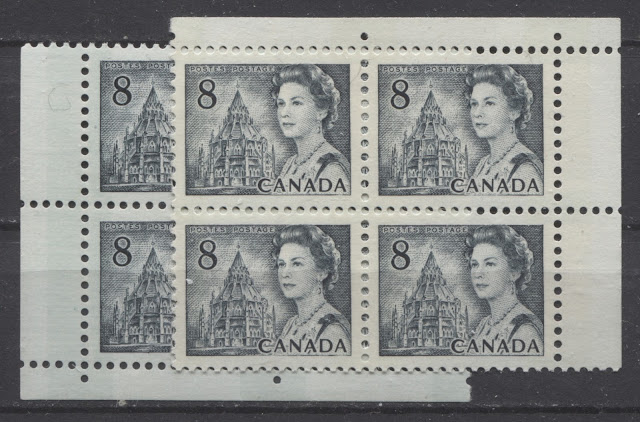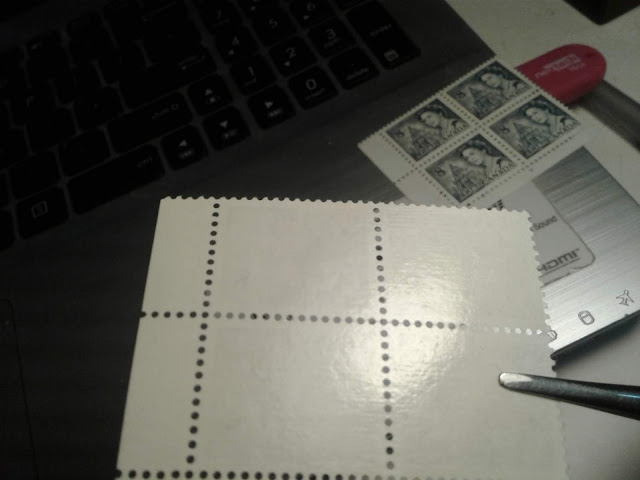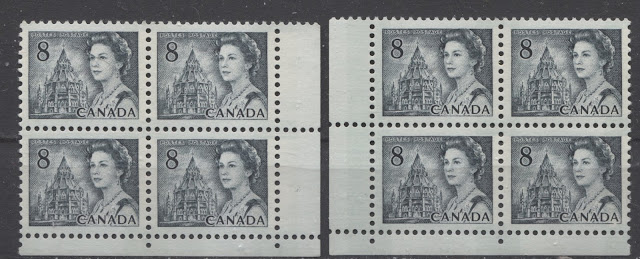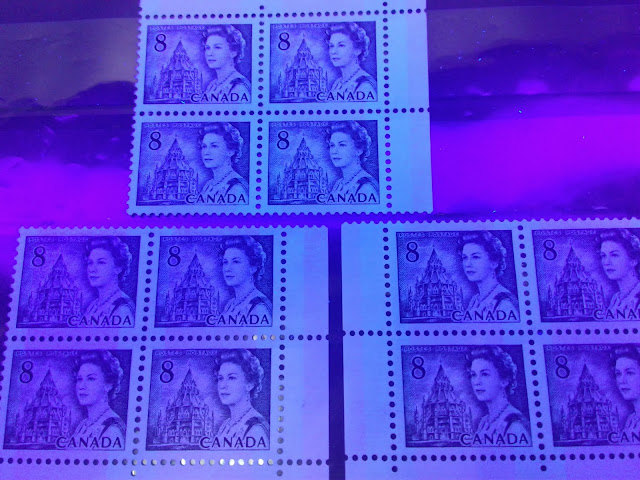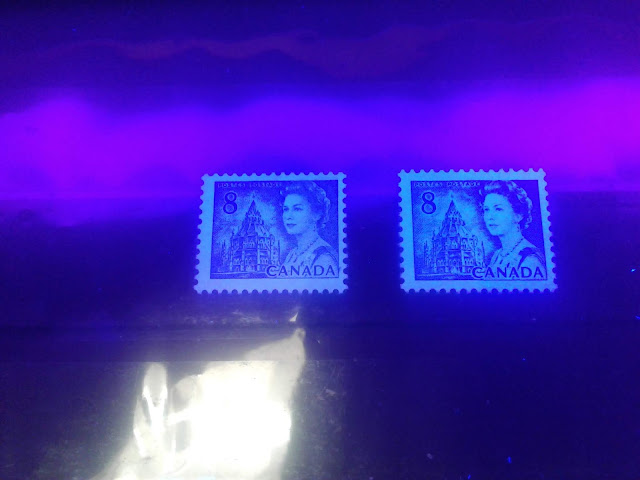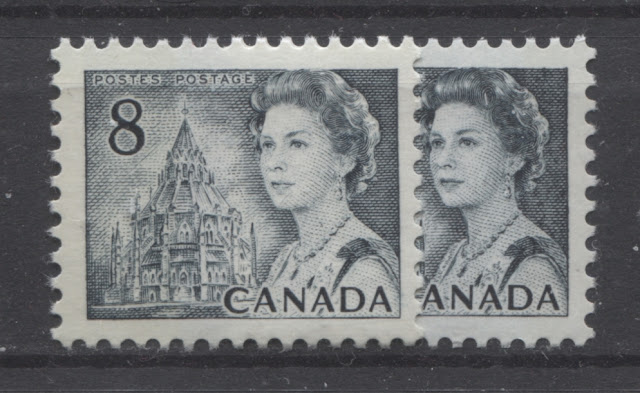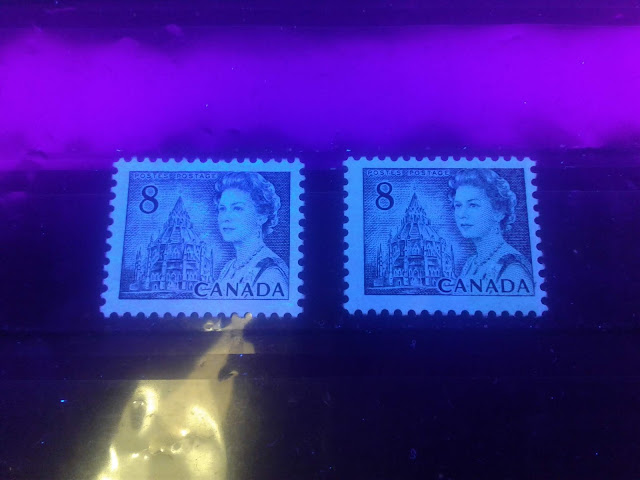This weeks's post continues my exploration of the printings of the 8c slate definitive from this series, which depicts the Parliamentary Library from the centre block of the Parliament Buildings in Ottawa. This week, I will examine the printings of the Winnipeg Tagged sheet stamps. The Winnipeg tagged stamps were issued with both dextrose gum and PVA gum. The dextrose gum printings were released at the same time as the untagged stamps on December 30, 1971. However, the PVA gum versions were released between July 1972 and November 1972, after the General Ottawa tagging replaced Winnipeg tagging as the standard tagging, which is interesting. This may account for the expensive nature of the printings on high fluorescent paper - because they were likely provisional printings made to fill in supply fluctuations of the Ottawa tagged stamps that happened when it became apparent that the OP-4 taggant that was being used for the Ottawa tagged stamps was unstable and needed to be replaced by a more stable compound.
Unitrade lists three basic varieties of the Winnipeg tagged sheet stamps as well as the "extra spire" variety on the PVA gum printings from plate 4. So, this will be a shorter post than last week. The amount of material in my stock that I have to work with is quite limited. So, it is quite likely that other varieties exist that I have not detailed here, but I will add them as they become apparent and I can write about them and illustrate them.
The Dextrose Gum Printings - Unitrade #544p
Paper Attributes Other Than Fluorescence
Apart from the fluorescence level, I have found three different types of paper used for the printings of these stamps:
- A strongly ribbed white horizontal wove paper. This is a reasonably stiff paper and does not bend overly easily. The vertical ribbing is very clearly visible on the printing face, and appears as a very strong vertical mesh pattern when the stamps are viewed against strong back lighting. The paper appears to be very lightly coated on the surface when examined under magnification.
- A weakly ribbed white horizontal wove paper. This is very similar to the paper above, except that the ribbing is almost invisible until the paper is held up to a strong backlight, when it becomes visible as a vertical mesh pattern that is not as strong as before.
- A softer, less stiff cream coloured horizontal wove paper. This paper is lightly coated on the surface just like the other papers. However, there is no visible ribbing on the paper surface, nor is there any visible mesh pattern when the stamps are held up and viewed through a strong back light. This paper is also lightly coated on the surface.
The following pictures illustrate the key attributes of each of these different papers:
This picture shows the noticeable difference between the cream papers and the white papers. I have placed a stark white stock card behind the above blocks to highlight the differences more fully. The white paper is shown on the left. It is not as white as the stark white, but it is still clearly white. The cream paper is illustrated by the block on the right.
This picture shows the non-ribbed paper viewed against strong backlighting. Note the complete absence of any visible mesh pattern in the paper.
This picture shows the weakly ribbed paper viewed against strong backlighting as well. Here, you can just see the vertical mesh pattern in the selvage tab on the left. However, it is not a strong appearing mesh pattern by any means.
Here is the strongly ribbed paper viewed against strong back lighting. Note how strong the vertical mesh pattern in the paper is.
Paper Fluorescence
Unitrade lists this stamp as only existing on non-fluorescent paper (NF). In my experience this is not correct. I have not yet seen a true non-fluorescent paper. What Unitrade calls non-fluorescent, is really more of a dull fluorescent greyish paper. There are also papers that read as low fluorescent overall, due to the inclusion of low fluorescent fibres in the paper.
The picture below shows the difference between the dull fluorescent greyish paper and one of the low fluorescent papers:
The dull fluorescent greyish paper is the stamp that is lying on top of the block in the centre. The block in the centre appears low fluorescent by comparison.
I have found seven different levels of fluorescence, which are all variations of dull fluorescence, but some of which read as low fluorescence, as shown in the pictures below
These two stamps are both dull fluorescent paper that does not contain any fluorescent fibres. The paper on the left is dull fluorescent greyish, while the paper on the right is a dull fluorescent blue grey.
Both of these blocks are on flecked papers. The paper of the block on the left is a dull fluorescent greyish white containing very sparse concentrations of both low and medium fluorescent fibres. The block on the right is a dull fluorescent bluish white with a very sparse concentration of low fluorescent fibres and a sparse concentration of medium fluorescent fibres. Overall, both blocks read as low fluorescent overall (1 on the Irwin scale for those of you familiar with that scale)
These are both flecked papers as well, but there is only a very sparse concentration of low fluorescent fibres in each, so the presence of the fibres does not alter the overall perceived level of fluorescence, which is still dull. The block on the left is dull fluorescent ivory, with a very sparse concentration of low fluorescent fibres. The block on the right is dull fluorescent greyish white, with a very sparse concentration of low fluorescent fibres.
This last block is also on flecked paper, but again, it still appears dull fluorescent overall, rather than low fluorescent. The paper appears dull fluorescent violet grey, with a very sparse concentration of low fluorescent fibres.Shades
The slate ink is a fairly uniform colour on these stamps. However, I have detected one slight variation that seems to occur on those printings that are on cream paper. The slate ink normally contains quite a lot of blue. However, I have found a slate ink that contains noticeably less blue. The scan below shows both shades of ink side by side in blocks of 4:
The normal deep bluish slate ink is shown on the left, while the right block is more of a pure deep slate shade. The shades do not appear any different under UV light, which means that the inks are non-transformative.
Gum
The gum on these stamps exhibits much the same variation as on the untagged stamps, though I have yet to locate an example with what can be called truly crackly gum. The three types of gum that I have located thus far on these stamps are:
- A high gloss smooth cream gum that shows light horizontal striations resembling brushstrokes.
- A semi-gloss gum that is similar to the above, but without the brushstroke appearance.
- A semi-smooth cream gum that shows a very slight crackliness when viewed at an angle, but overall appears smooth.
These three types of gum, as they appear on this stamp are shown in the pictures below:
The semi-smooth gum. You can just see a very slight crackliness to the surface, but overall it appers smooth.
The high gloss gum showing the tell-tale light reflection in the surface.
The semi-gloss gum. Note how there is no crackliness to the surface, but at the same time, there is much less reflection of light.
Perforation
Like the untagged stamps, these stamps are comb perforated 12.5 x 12. I have not found any variation in the gauge of the perforation. The configuration of the perforation as to the sheets is also the same in the sense that the horizontal perforations extend all the way through the sheet margins, while the vertical perforations extend one hole into each of the top and bottom margins.
Tagging
The tagging on these stamps consists of 8 mm bands that were applied down the vertical perforations in the sheet resulting in 4 mm bands approximately on each side of the stamp. The spacing between each band was approximately 16 mm and unlike earlier versions of the Winnipeg tagging, there does not appear to be any variation between the horizontal spacing between tagging bars.
In normal light the tagging bars are somewhat difficult to see on most stamps, and appear as a slight discolouration of the paper on the sides of the stamp. However, occasionally the slate ink has coloured the paper and tagging, causing it to take on a light bluish appearance and thus making it easier to see. The scan below shows two different blocks with both types of tagging:
The block on the left shows the appearance of the normal Winnipeg tagging on a white paper block. It is very, very difficult to see. However if you look at the right selvage tab just under half way over from the left you can just see a vertical line of very light discolouration. The block on the right shows the very light bluish bands and the resulting discolouration of the paper is much more visible in the selvage tabs.
Under UV light, the tagging glows a light bluish white colour, and this glow is the same for all blocks that I examined as shown in the picture below:
Tagging Errors
Rose lists only one tagging error on the dextrose gum printings, being what he classifies as W2aL, which means a single 8 mm band on the left side of the stamp, and no band at all visible on the right.
Plate Flaws
There are no listed major plate flaws on the dextrose gum printings. As Unitrade states, there are over 75 constant plate (cylinder) varieties on this value. It is not clear whether or not all of these are from a single plate, or whether some occur on some plates, but not others. I believe that Robin Harris lists most of them in his book about the Centennial Definitives.
Bringing It All Together
Although these were printed from plates 1, 2 and 3, there are no plate inscriptions for any of the blocks, since these are tagged issues, and all tagged stamps were trimmed of plate inscriptions prior to distribution. I have identified 3 different types of paper, 7 levels of fluorescence, 2 shades, 3 types of gum, 2 different appearances to the tagging and the tagging errors. It is not clear if each variety can be found in tandem with the others - some types of paper may only exist with 1 or 2 levels f fluorescence. However, if they all exist in the maximum number of permutations, then there could be as many as: 3 x 7 x 2 x 3 x 2 x 2 = 492 different collectible stamps. There are 12 different collectible positions of each corner block, so that there could be up to 492 x 12 = 5,904 different collectible corner blocks.
The PVA Gum Printings - Unitrade #544pii, 544piii and 544piv
Unitrade lists two basic varieties of this stamp. #544pii is the low fluorescent paper, which according to Unitrade was released in July 1972. #544piii is the high fluorescent paper and according to Unitrade it was released in November 1972.
Paper Attributes Other Than Fluorescence
I have found only one single type of paper used to print these stamps. It is a thinner horizontal wove paper, which shows clear vertical ribbing on the printing surface of the paper. This paper has a light surface coating, and a strong vertical mesh pattern is visible when the stamps are held up to the light.
Paper Fluorescence
Unitrade lists this stamp as existing on both low and high fluorescent paper. Again their listings are confusing because both of these types of paper are flecked papers that contain high concentrations of fluorescent fibres that significantly raise the overall perceived levels of fluorescence. Rose lists a medium fluorescent paper, which definitely does exist. In practice, I have found no fewer than six levels of fluorescence, ranging from dull fluorescent greyish to high fluorescent.
The pictures below illustrate these varieties:
The stamp on the right is a dull fluorescent greyish colour under UV light. There are no obvious fluorescent fibres in the paper, but on very close examination, you can just make out 1 or 2 low fluorescent fibres. If you examine the back, you can see a very few brownish woodpulp fibres in the paper. The stamp on the right is the standard low fluorescent paper that is listed in Unitrade. It is a dull fluorescent greyish white colour under UV and contains sparse concentrations of both low and medium fluorescent fibres.
The stamp on the left is a slightly different version of the low fluorescent paper. The difference is that instead of sparse concentrations of low and medium fluorescent fibres, it contains only a very sparse concentration of medium fluorescent fibres and a sparse concentration of low fluorescent fibres, and it is greyish rather than greyish white. The stamp on the right is the high fluorescent paper. It is actually a low fluorescent greyish white paper containing low density concetrations of low and medium fluorescent fibres, a sparse concentration of high fluorescent fibres and a sparse concentration of brownish woodpulp fibres.
The stamp on the left is the medium fluorescent paper, while the one on the right is a slightly different version of the high fluorescent paper. The stamp on the left is dull fluorescent greyish, but contains a sparse concentration of both low and medium fluorescent fibres. The stamp on the right is very similar to the other high fluorescent paper, in terms of its overall appearance. But instead of the basic paper fluorescence being low, with the fibres raising it to high, it is dull fluorescent greyish, with low density concentrations of low, medium and high fluorescent fibres, which raise it to an overall fluorescence level of high.
Shades
Like the dextrose gum stamps, the shades of ink are fairly uniform. I have found two slightly different shades as before. One is a deep bluish slate and the other is less bluish, containing a hint of grey. The scan below shows the two shades side by side:
The bluish slate is shown on the right, and the more greyish slate is shown in the stamp on the left.
Gum
The gum on all of these stamps is a white, smooth PVA gum that has a satin sheen.
Perforation
The perforation of the PVA gum printings is exactly the same as for the previous dextrose gum printing, being comb 12.5 x 12, with the same configuration on the sheets.
Tagging
The tagging on the PVA gum printings is the same as for the dextrose gum printings. However, because of the fluorescence of the paper of most stamps that it appears on it is much more difficult to see. It usually appears as a slight dulling of the fluorescent effect on both sides of the stamp. The picture below shows how this tagging usually appears under UV light:
If you look at this picture carefully, you can see clear bands of discolouration along the left and right edges of the stamp. The band on the left side stops just short of the right edge of the "8". The band on the right is narrower, bisecting the last "A" of "Canada".
Tagging Errors
Rose lists four different tagging errors on the PVA gum printings: two on what Rose calls medium fluorescent paper and two on high fluorescent paper:
- A W2aL variety in which there is a single 8 mm band running down the left side of the stamp. This is found on both types of paper.
- A W2aR variety in which there is a single 8 mm band running down the right side of the stamp. This is also found on both types of paper.
The picture below illustrates both of these errors, though they are very difficult to see because of the paper fluorescence:
Plate Flaws
As all of the Winnipeg tagged PVA gum stamps were printed from plate 4, they exist with the "extra spire" flaw that was discussed in last week's post. There are no other major listed constant plate flaws for this stamp. However, as stated in Unitrade, there are more than 75 constant cylinder varieties on this stamp. It is not clear though how many of these exist on the plate 4 printings with Winnipeg tagging.
Bringing It All Together
This is a much simpler stamp than the dextrose gum stamp. I have only identified one type of paper, six levels of fluorescence, 2 shades and the two tagging errors, which effectively means three different types of tagging (the two errors and the normal). Therefore there could exist as many as 36 different collectible stamps and 36 x 12 = 432 different corner blocks.
This concludes my examination of the Winnipeg tagged sheet stamps. Next week, I will look at the printings of the General Ottawa Tagged sheet stamps and the tagged coil stamps that were printed by the CBN.



